If you want to know about the staircase design or landscape garden or requirements for disabled persons in a building, please click the link.
Introduction
Microclimates are small-scale areas with distinct climate conditions that differ from the surrounding climate. They are influenced by factors such as topography, vegetation, surface materials, water bodies, and human activity. In architecture, microclimates play an important role in determining the comfort, energy efficiency, sustainability, and aesthetics of buildings.

Understanding microclimates is crucial in architectural design because it allows architects to make informed decisions about the placement, orientation, and design of buildings. By taking advantage of microclimates, architects can create more comfortable and energy-efficient buildings, reduce the environmental impact of construction, and improve the resilience of buildings to climate change and extreme weather events.
1) Factors that affect microclimates
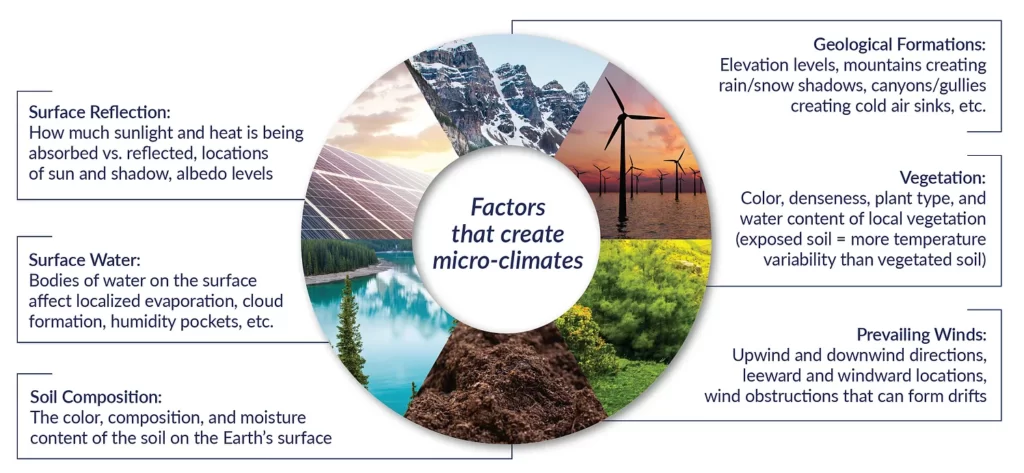
Microclimates are influenced by various factors, including:
i) Topography
The shape and orientation of the land can affect the microclimate of a particular area. For example, a valley or depression can trap cold air, resulting in lower temperatures, while a hill or mountain can block wind and influence precipitation patterns.
ii) Vegetation
The type and density of vegetation can impact the microclimate of an area. Trees and shrubs can provide shade, reduce wind speed, and increase humidity levels, while grass and other ground cover can help regulate surface temperatures.
iii) Surface materials
Different types of surface materials, such as asphalt, concrete, and water, can absorb and reflect heat differently, leading to variations in temperature and humidity levels. For example, urban areas with high concentrations of concrete and asphalt tend to be hotter than rural areas with more vegetation and natural surfaces.
iv) Water bodies
The presence of water bodies, such as lakes, rivers, and oceans, can influence the temperature and humidity of the surrounding area. Water has a high heat capacity, meaning it can store and release large amounts of heat, which can affect the local climate.
v) Human activity
Human activities, such as construction, transportation, and industrial processes, can generate heat, pollutants, and other emissions that impact the microclimate of an area. Urban areas with high levels of human activity tend to have higher temperatures and lower air quality than rural areas.
vi) Climate change
Climate change is altering the global climate and affecting microclimates in different ways. For example, rising temperatures are causing heat waves to become more frequent and intense, while changes in precipitation patterns are leading to more frequent droughts and floods. Architects must consider these changes when designing buildings that are resilient to future climate conditions.
2) Types of microclimates
Microclimates can vary depending on the location and environmental conditions. Here are some common types of microclimates:
i) Urban microclimates
Urban areas often have distinct microclimates due to the influence of human activity and the built environment. For example, cities tend to be hotter than surrounding rural areas due to the urban heat island effect, which is caused by the absorption and re-emission of heat by buildings and pavement.

ii) Indoor microclimates
The microclimate inside a building can be influenced by factors such as ventilation, heating, and cooling systems, as well as the materials and finishes used in the construction. Indoor microclimates can have a significant impact on the comfort and wellbeing of occupants, as well as energy consumption and indoor air quality.

iii) Coastal microclimates
Coastal areas have unique microclimates due to their proximity to large bodies of water. Coastal microclimates tend to be more humid and have milder temperatures compared to inland areas, and may also be affected by ocean currents, sea breezes, and fog.
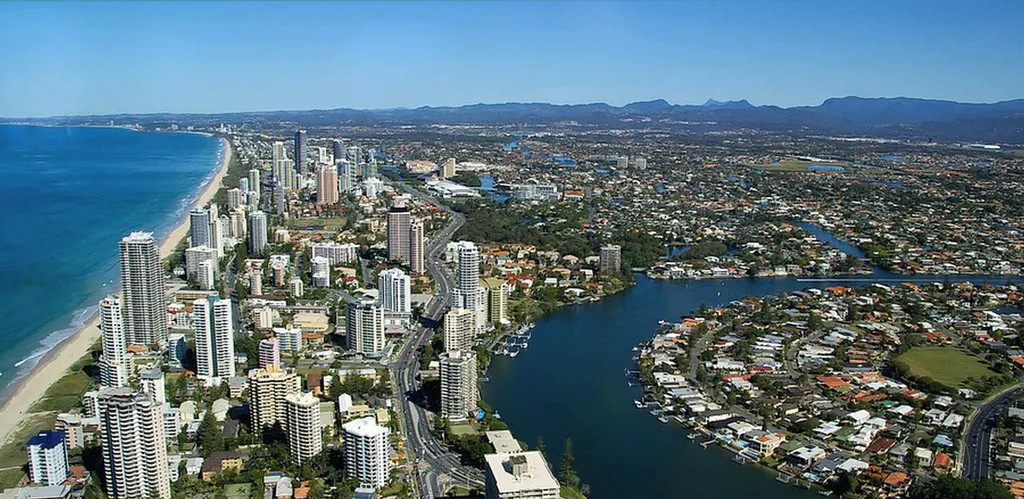
iv) Mountain microclimates
Mountainous regions often have highly variable microclimates due to changes in elevation and slope orientation. As altitude increases, temperatures tend to decrease, while precipitation patterns can also change. Mountain microclimates can be important for activities such as agriculture, recreation, and tourism.

v) Desert microclimates
Deserts have distinct microclimates characterized by low humidity, high temperatures during the day, and rapid cooling at night. Desert microclimates can also be influenced by topography, such as canyons and valleys, which can trap or funnel wind and create temperature variations.

vi) Forest microclimates
Forests have unique microclimates due to the presence of vegetation and the amount of sunlight that penetrates the canopy. Forest microclimates tend to be cooler and more humid than surrounding areas, and may also be affected by factors such as altitude and soil type. Forests play an important role in regulating the global climate by absorbing and storing carbon dioxide.

3) Importance of understanding microclimates in architecture
Architects need to consider microclimates when designing buildings in order to achieve optimal performance, comfort, and sustainability. Here are some ways that understanding microclimates can benefit architectural design:
i) Comfort and wellbeing
Designing buildings that respond to local microclimates can help improve the comfort and wellbeing of occupants. For example, buildings that are designed to take advantage of natural ventilation and shading can reduce the need for mechanical cooling and improve indoor air quality.
ii) Energy efficiency
By designing buildings that respond to local microclimates, architects can reduce energy consumption and greenhouse gas emissions. For example, buildings that are designed to maximize passive solar heating and natural ventilation can reduce the need for artificial heating and cooling systems, resulting in lower energy bills and reduced environmental impact.
iii) Sustainability
Understanding microclimates is important for designing buildings that are sustainable and resilient. By taking into account the local climate, architects can design buildings that are better adapted to their environment, use renewable resources, and reduce waste and energy consumption.
iv) Aesthetics
Microclimates can also influence the aesthetic qualities of buildings and landscapes. By understanding the local microclimate, architects can design buildings that are visually appealing and responsive to the natural environment.
v) Resilience
Designing buildings that respond to local microclimates can also improve their resilience to natural disasters such as floods, hurricanes, and wildfires. By designing buildings that are adapted to local environmental conditions, architects can create structures that are more resilient to extreme weather events and better able to withstand the impacts of climate change.
4) Design strategies for microclimates
Architects can use a range of design strategies to create buildings that respond to local microclimates. Here are some examples:
i) Passive design strategies
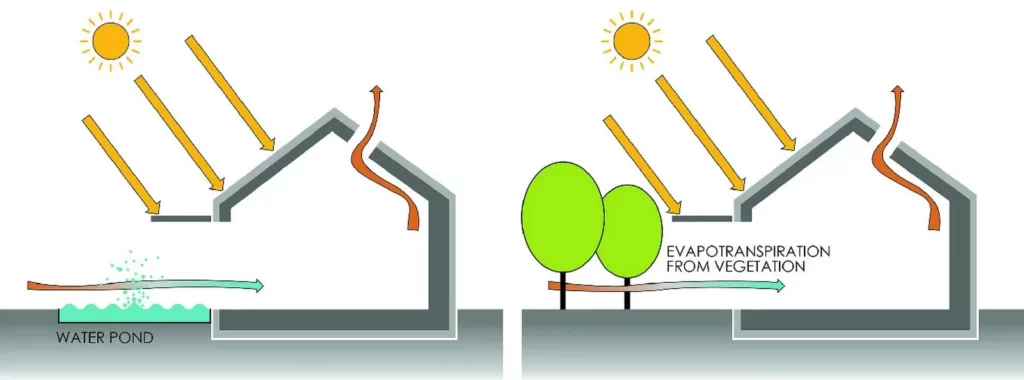
Passive design strategies use the natural environment to regulate temperature, lighting, and ventilation within a building. Some examples include:
- Shading and insulation: Using shading devices such as eaves, pergolas, and louvers to prevent direct sunlight from entering the building can help reduce heat gain and maintain comfortable indoor temperatures. Insulating walls, roofs, and floors can also help reduce heat loss and maintain indoor temperatures.
- Natural ventilation: Designing buildings with operable windows, doors, and vents can help promote natural air movement and improve indoor air quality. Cross-ventilation and stack effect can also be used to promote natural ventilation.
- Thermal mass: Using materials with high thermal mass such as concrete, stone, or brick can help stabilize indoor temperatures by absorbing and releasing heat slowly.
ii) Active design strategies
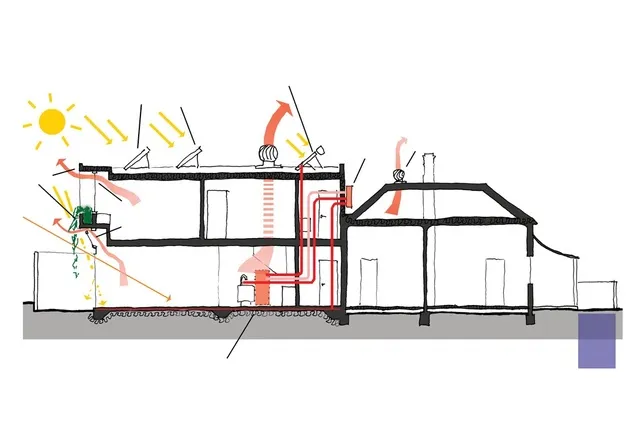
Active design strategies use mechanical or electrical systems to regulate temperature, lighting, and ventilation within a building. Some examples include:
- HVAC systems: Heating, ventilation, and air conditioning (HVAC) systems can be used to maintain comfortable indoor temperatures and improve indoor air quality. HVAC systems can also be designed to use renewable energy sources such as solar, geothermal, or wind power.
- Artificial lighting: Using energy-efficient lighting systems such as LED or fluorescent bulbs can help reduce energy consumption and improve the visual comfort of occupants.
- Water management: Designing buildings that use rainwater harvesting, greywater recycling, and low-flow fixtures can help reduce water consumption and improve the sustainability of the building.
iii) Case studies of microclimate-responsive buildings
Here are some examples of buildings that are designed to respond to local microclimates:
- The Bullitt Center in Seattle, USA: This office building is designed to be energy-efficient and sustainable, using strategies such as passive solar heating, natural ventilation, and rainwater harvesting. The building also has a green roof and solar panels to generate renewable energy.
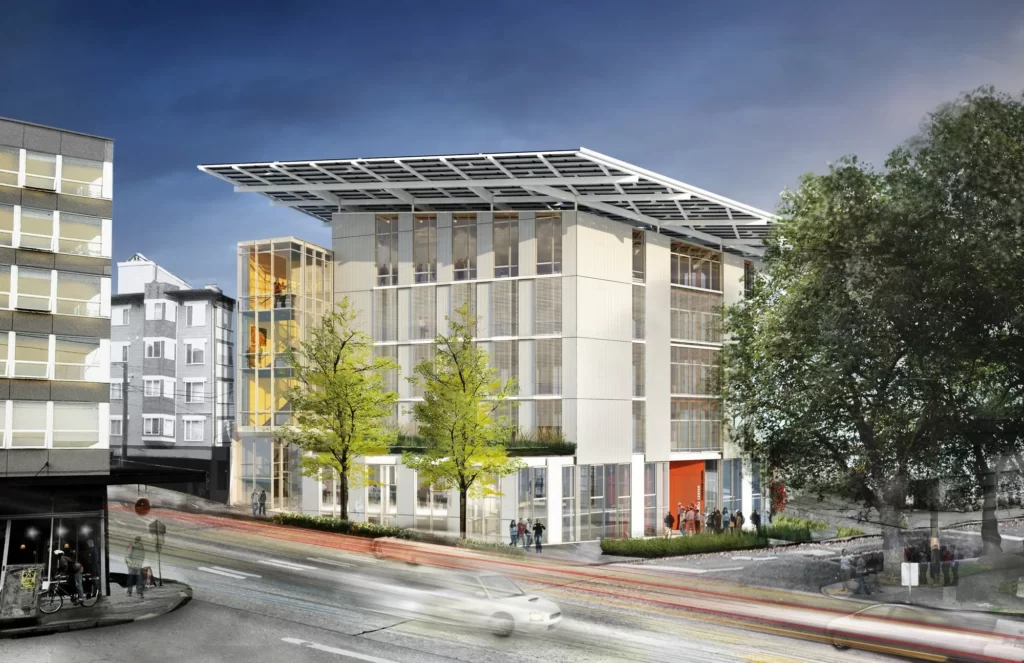
- The Yellow Treehouse Restaurant in Auckland, New Zealand: This restaurant is built around a single tree and is designed to blend in with the surrounding forest. The building is elevated to minimize its impact on the forest floor and is designed to maximize natural light and ventilation.
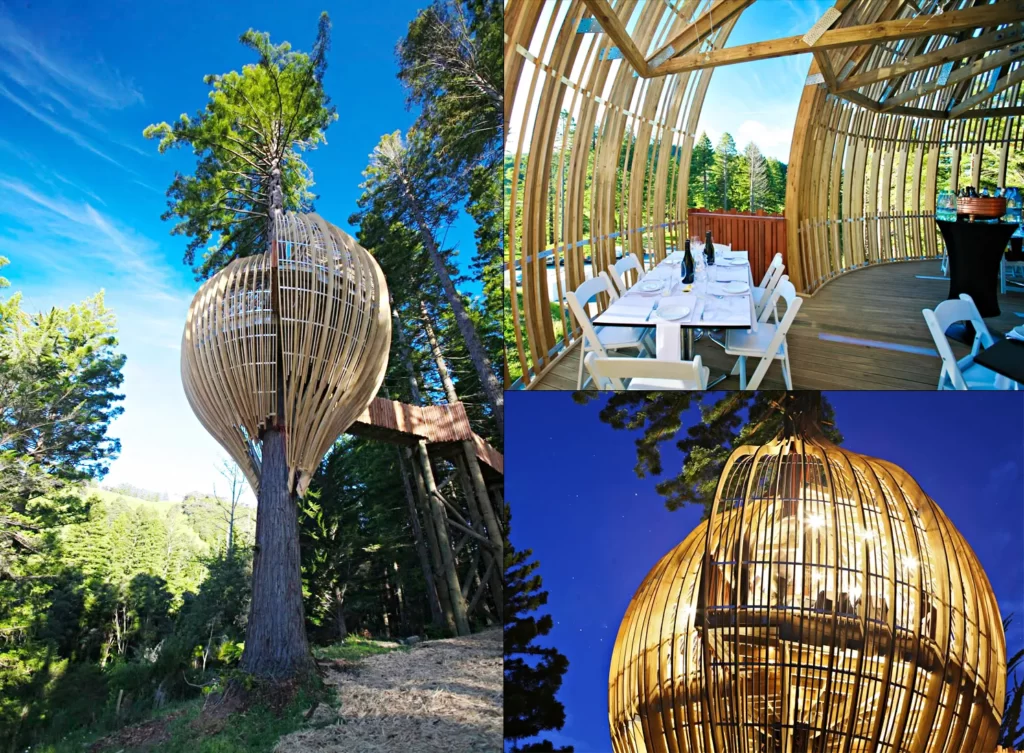
- The Green School in Bali, Indonesia: This school is designed to be sustainable and eco-friendly, using natural materials such as bamboo and mud bricks. The buildings are designed to maximize natural light and ventilation, and the school also has a permaculture garden and composting system.
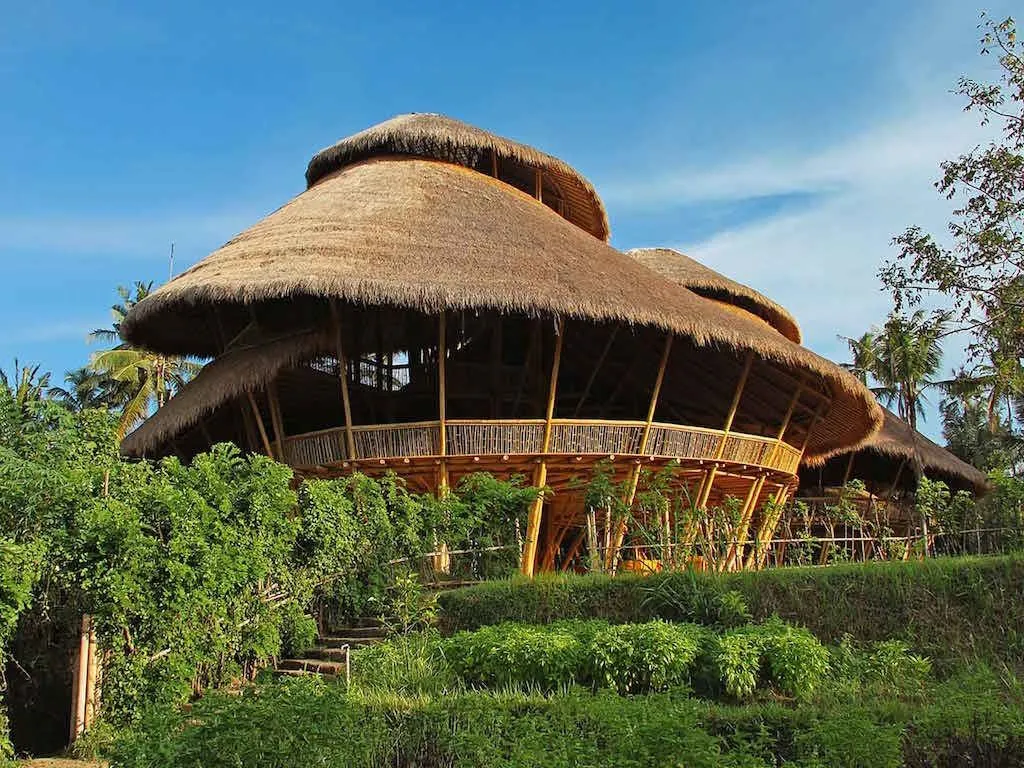
5) Conclusion
In conclusion, understanding microclimates is essential for architects to design buildings that are sustainable, energy-efficient, and resilient. Microclimates are influenced by a range of factors such as topography, vegetation, surface materials, water bodies, human activity, and climate change. Architects can use a range of design strategies such as passive and active systems to create buildings that respond to local microclimates.
Call to action:
Architects have a critical role to play in creating buildings that respond to local microclimates. By taking into account the local climate and environment, architects can design buildings that are comfortable, energy-efficient, and sustainable. We encourage architects to consider microclimates in their designs and to prioritize sustainability and resilience in their work.
In conclusion, understanding microclimates is a critical aspect of designing sustainable and resilient buildings. Architects must consider the local climate and environment in their designs and use a range of strategies to create buildings that respond to local microclimates. For further reading, we recommend exploring resources on sustainable design, green building practices, and climate-responsive architecture.